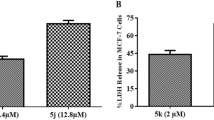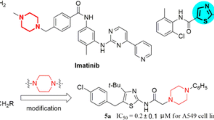Abstract
Piperazine scaffolds or 2-azetidinone pharmacophores have been reported to show anti-cancer activities and apoptosis induction in different types of cancer cells. However, the mechanistic studies involve in induction of apoptosis addressing these two moieties for human cervical cancer cells remain uncertain. The present study emphasizes on the anti-proliferating properties and mechanism involved in induction of apoptosis for these structurally related azoles derivatives in HeLa cancer cells. 1-Phenylpiperazine clubbed with 2-azetidione derivatives (5a–5h) were synthesized, characterized using various spectroscopic techniques and evaluated for their in-vitro anti-proliferative activities and induction of apoptosis. Further, we also evaluated oxidative stress generated by these synthetic derivatives (5a–5h). Cell viability studies revealed that among all, the compound N-(3-chloro-2-(3-nitrophenyl)-4-oxoazetidin-1-yl)-2-(4-phenylpiperazin-1-yl) acetamide 5e remarkably inhibited the growth of HeLa cells in a concentration dependent manner having IC50 value of 29.44 ± 1.46 µg/ml. Morphological changes, colonies suppression and inhibition of migration clearly showed the antineoplasicity in HeLa cells treated with 5e. Simultaneously, phosphatidylserine externalization, DNA fragmentation and cell-cycle arrest showed ongoing apoptosis in the HeLa cancer cells induced by compound 5e in concentration dependent manner. Additionally, generation of intracellular ROS along with the decrease in mitochondrial membrane potential supported that compound 5e caused oxidative stress resulting in apoptosis through mitochondria mediated pathway. Elevation in the level of cytochrome c and upregulation in expression of caspase-3 clearly indicated the involvement of the intrinsic pathway of programmed cell death. In brief; compound 5e could serve as a promising lead for the development of an effective antitumor agent.
Graphical Abstract













Similar content being viewed by others
Abbreviations
- MTT:
-
3-(4,5-Dimethylthiazol-2-yl)-2.5-diphenyl-tetrazolium bromide
- DCFH-DA:
-
2′,7′-Dichlorofluorescin diacetate
- AO:
-
Acridine organe
- ROS:
-
Reactive oxygen species
- MMP:
-
Mitochondrial membrane potential
- RPMI:
-
Roswell Park Memorial Institute medium
References
Khazaei S, Ramachandran V, Abdul Hamid R, Esa NM, Etemad A, Moradipoor S, Ismail P (2017) Flower extract of Allium atroviolaceum triggered apoptosis, activated caspase-3 and down-regulated antiapoptotic Bcl-2 gene in HeLa cancer cell line. Biomed Pharmacother 89:1216–1226
World Health Organization (2014) GLOBOCAN2012: estimated cancer incidence, mortality and prevalence worldwide in 2012. International agency for research on cancer, population fact sheets (Islamic Republic of Iran)
Fulda S (2009) Tumor resistance to apoptosis. Int J Cancer 124:511–515
Thangam R, Sathuvan M, Poongodi A, Suresh V, Pazhanichamy K, Sivasubramanian S, Kanipandian N, Ganesan N, Rengasamy R, Thirumurugan R (2014) Activation of intrinsic apoptotic signaling pathway in cancer cells by Cymbopogon citratus polysaccharide fractions. Carbohydr Polym 107:138–150
Alshatwi AA, Periasamy VS, Athinarayanan J, Elango R (2016) Synergistic anticancer activity of dietary tea polyphenols and bleomycin hydrochloride in human cervical cancer cell: caspase-dependent and independent apoptotic pathways. Chem Biol Interact 247:1–10
Ahmed W, Van Etten RA (2013) Signal transduction in the chronic leukemias: implications for targeted therapies. Curr Hematol Malig Rep 8:71–80
Asif M (2015) Piperazine and pyrazine containing molecules and their diverse pharmacological activities. Int J Adv Sci Res 1:05–11
Berkheij M, van der Sluis L, Sewing C, den Boer DJ, Terpstra JW, Hiemstra H, Bakker WII, van den Hoogenband A, van Maarseveen JH (2005) Synthesis of 2-substituted piperazines via direct α-lithiation. Tetrahedron Lett 46:2369–2371
Wilson WD, Barton HJ, Tanious FA, Kong S-B, Strekowski L (1990) The interaction with DNA of unfused aromatic systems containing terminal piperazino substituents: intercalation and groove-binding. Biophys Chem 35:227–243
Gillet R, Jeannesson P, Sefraoui H, Arnould-Guerin M-L, Kirkiacharian S, Jardillier J-C, Pieri F (1997) Piperazine derivatives of butyric acid as differentiating agents in human leukemic cells. Cancer Chemother Pharmacol 41:252–255
Upadhayaya RS, Sinha N, Jain S, Kishore N, Chandra R, Arora SK (2004) Optically active antifungal azoles: synthesis and antifungal activity of (2R, 3S)-2-(2, 4-difluorophenyl)-3-(5-{2-[4-aryl-piperazin-1-yl]-ethyl}-tetrazol-2-yl/1-yl)-1-[1, 2, 4]-triazol-1-yl-butan-2-ol. Bioorg Med Chem 12:2225–2238
Chaudhary P, Kumar R, Verma AK, Singh D, Yadav V, Chhillar AK, Sharma G, Chandra R (2006) Synthesis and antimicrobial activity of N-alkyl and N-aryl piperazine derivatives. Bioorg Med Chem 14:1819–1826
Yoshida M, Maehara Y, Sugimachi K (1999) MST-16, a novel bis-dioxopiperazine anticancer agent, ameliorates doxorubicin-induced acute toxicity while maintaining antitumor efficacy. Clin Cancer Res 5:4295–4300
Hatnapure GD, Keche AP, Rodge AH, Birajdar SS, Tale RH, Kamble VM (2012) Synthesis and biological evaluation of novel piperazine derivatives of flavone as potent anti-inflammatory and antimicrobial agent. Bioorg Med Chem Lett 22:6385–6390
Shaquiquzzaman M, Verma G, Marella A, Akhter M, Akhtar W, Khan MF, Tasneem S, Alam MM (2015) Piperazine scaffold: a remarkable tool in generation of diverse pharmacological agents. Eur J Med Chem 102:487–529
Sun J (2017) Discovery of a series of 1,3,4-oxadiazole-2(3H)-thione derivatives containing piperazine skeleton as potential FAK inhibitors. Bioorg Med Chem Lett 25:2593–2600
Guo FJ, Sun J, Gao LL, Wang XY, Zhang Y, Qian SS, Zhu HL (2015) Discovery of phenylpiperazine derivatives as IGF-1R inhibitor with potent antiproliferative properties in vitro. Bioorg Med Chem Lett 25:1067–1071
da Silva DD, Silva MJ, Moreira P, Martins MJ, Valente MJ, Carvalho F, de Lourdes Bastos M, Carmo H (2016) In vitro hepatotoxicity of ‘Legal X’: the combination of 1 benzylpiperazine (BZP) and 1 (m trifluoromethylphenyl) piperazine (TFMPP) triggers oxidative stress, mitochondrial impairment and apoptosis. Springer, Heidelberg
Mehta PD, Sengar NP, Pathak AK (2010) 2-Azetidinone–a new profile of various pharmacological activities. Eur J Med Chem 45:5541–5560
Arya N, Jagdale AY, Patil TA, Yeramwar SS, Holikatti SS, Dwivedi J, Shishoo CJ, Jain KS (2014) The chemistry and biological potential of azetidin-2-ones. Eur J Med Chem 74:619–656
Smith DM, Kazi A, Smith L, Long TE, Heldreth B, Turos E, Dou QP (2002) A novel beta-lactam antibiotic activates tumor cell apoptotic program by inducing DNA damage. Mol Pharmacol 61:1348–1358
Dhivya R (2015) In virto antiprolifeative and apoptosis-inducing properties of a mononuclear copper (II) complex with dppz ligand, i = n two genotypically different breast cancer cell lines. Springer, New York
Wani MY, Ahmad A, Shiekh RA, Al-Ghamdi KJ, Sobral AJ (2015) Imidazole clubbed 1,3,4-oxadiazole derivatives as potential antifungal agents. Bioorg Med Chem 23:4172–4180
Unver Y, Sancak K, Celik F, Birinci E, Kucuk M, Soylu S, Burnaz NA (2014) New thiophene-1,2,4-triazole-5(3)-ones: highly bioactive thiosemicarbazides, structures of Schiff bases and triazole-thiols. Eur J Med Chem 84:639–650
O’Boyle NM, Greene LM, Bergin O, Fichet JB, McCabe T, Lloyd DG, Zisterer DM, Meegan MJ (2011) Synthesis, evaluation and structural studies of antiproliferative tubulin-targeting azetidin-2-ones. Bioorg Med Chem 19:2306–2325
Morris GM (1998) Automated docking using a Lamarckian genetic algorithm and an empirical binding free energy function. J Comput Chem 19:1639–1662
Cohen G, Sun X, Snowden R, Dinsdale D, Skilleter D (1992) Key morphological features of apoptosis may occur in the absence of internucleosomal DNA fragmentation. Biochem J 286:331–334
Yu Z, Wang R, Xu L, Xie S, Dong J, Jing Y (2011) β-Elemene piperazine derivatives induce apoptosis in human leukemia cells through downregulation of c-FLIP and generation of ROS. PLoS ONE 6:e15843
Geesala R, Gangasani JK, Budde M, Balasubramanian S, Vaidya JR, Das A (2016) 2-Azetidinones: synthesis and biological evaluation as potential anti-breast cancer agents. Eur J Med Chem 124:544–558
Shyam H, Singh N, Kaushik S, Sharma R, Balapure AK (2017) Centchroman induces redox-dependent apoptosis and cell-cycle arrest in human endometrial cancer cells. Apoptosis 22:570–584
Aarts M, Sharpe R, Garcia-Murillas I, Gevensleben H, Hurd MS, Shumway SD, Toniatti C, Ashworth A, Turner NC (2012) Forced mitotic entry of S-phase cells as a therapeutic strategy induced by inhibition of WEE1. Cancer Discov 2:524–539
Kumar R, Tiku A (2018) Galangin induces cell death by modulating the expression of glyoxalase-1 and Nrf-2 in HeLa cells. Chem Biol Interact 279:1–9
Tentner AR, Lee MJ, Ostheimer GJ, Samson LD, Lauffenburger DA, Yaffe MB (2012) Combined experimental and computational analysis of DNA damage signaling reveals context-dependent roles for Erk in apoptosis and G1/S arrest after genotoxic stress. Mol Syst Biol 8, 568
Gasparri F, Cappella P, Galvani A (2006) Multiparametric cell cycle analysis by automated microscopy. J Biomol Screen 11:586–598
Liu Y-J, Liang Z-H, Hong X-L, Li Z-Z, Yao J-H, Huang H-L (2012) Synthesis, characterization, cytotoxicity, apoptotic inducing activity, cellular uptake, interaction of DNA binding and antioxidant activity studies of ruthenium (II) complexes. Inorg Chim Acta 387:117–124
Khanam R, Ahmad K, Hejazi II, Siddique IA, Kumar V, Bhat AR, Azam A, Athar F (2017) Inhibitory growth evaluation and apoptosis induction in MCF-7 cancer cells by new 5-aryl-2-butylthio-1,3,4-oxadiazole derivatives. Cancer Chemother Pharmacol 80:1027–1042
Hejazi II, Khanam R, Mehdi SH, Bhat AR, Rizvi MMA, Islam A, Thakur SC, Athar F (2017) New insights into the antioxidant and apoptotic potential of Glycyrrhiza glabra L. during hydrogen peroxide mediated oxidative stress: an in vitro and in silico evaluation. Biomed Pharmacother 94:265–279
Simon HU, Haj-Yehia A, Levi-Schaffer F (2000) Role of reactive oxygen species (ROS) in apoptosis induction. Apoptosis 5:415–418
Acknowledgements
The research work has been funded by UGC (F no-43-172/2014 (SR)).
Author information
Authors and Affiliations
Corresponding authors
Ethics declarations
Conflict of interest
All authors declare no conflict of interest.
Ethical approval
This article has no studies concerned with human participants or animals.
Electronic supplementary material
Below is the link to the electronic supplementary material.
10495_2018_1439_MOESM1_ESM.docx
Includes NMR spectral analysis and bar graph for cell viability assay (Figs. S.1, S.2, S.3, S.4 and S.5). (DOCX 7879 KB)
Rights and permissions
About this article
Cite this article
Khanam, R., Kumar, R., Hejazi, I.I. et al. Piperazine clubbed with 2-azetidinone derivatives suppresses proliferation, migration and induces apoptosis in human cervical cancer HeLa cells through oxidative stress mediated intrinsic mitochondrial pathway. Apoptosis 23, 113–131 (2018). https://doi.org/10.1007/s10495-018-1439-x
Published:
Issue Date:
DOI: https://doi.org/10.1007/s10495-018-1439-x




